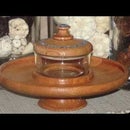Introduction: 3D PEACE SIGN WITH a FLUID ACRYLIC POUR FINISH
I collect a lot of pieces of scrap wood from my woodworking projects. To maintain my commitment of caring for the environment (and not spending money for the things I make), I'll turn the wood scraps into art pieces. The peace sign is a simple design and making it in 3D in really easy.
The finish I used for the interior parts is called Fluid Acrylic Painting or Fluid Acrylic Pour. I recently learned this technique from a very talented artist, Andrea Mercier. There is a link to her YouTube channel attached to this Instructable where you can learn how to make these paints.
Also there is a link to my YouTube channel showing how I made this peace sign.
I hope you enjoy this Instructable. Questions, comments or suggestions are always welcome.
Thank you for viewing this Instructable.
Step 1: Supplies and Tools
Peace sign cut out (2)
Wood cut into a round circle to equal the size of the peace sign
Wood big enough to fit the four inside pieces of the peace sign.
Hot glue, spray adhesive, glue stick or double sided tape
Acrylic paints
Jig saw, scroll saw or band saw
Router or wood file
Wipe on or spray polyurethane
X-Acto knife or single edge razor
Glitter
Heat gun
Optional items and equipment
Drill
Drill bit
Wood dowel
Step 2: Preparing the Wood
Take one of the peace sign cutouts and cut out the 4 interior parts. Don't cut directly on the line, leave a small border around each segment. Using spray adhesive, glue stick or double sided tape attach each paper segment to a piece of wood. Cover each piece with clear packing tape. This step is optional but I highly recommend using the packing tape as it will help reduce tear out when cutting the wood to shape.
Step 3: Cutting and Shaping the Wood
Cut the interior pieces of the peace sign as close to the line as possible. I used a band saw, you can use a jig saw or scroll saw. Once cut, using a wood file or a disc sander shape the pieces right up to the line.
Once you have the pieces shaped and are satisfied with the result remove the paper from the wood pieces. You'll probably need to use some sand paper to get all the paper and glue off. Once the paper is completely off round off the edges using a wood file or router with a round over bit.
I used the router but you can can get equally good results with a wood file. This step is optional but it does give your work a more finished look.
Now you are ready to apply the acrylic pour finish.
Step 4: Preparing the Wood for the Acrylic Pour Finish
If you are new to fluid acrylic pour (FAP) I encourage you to watch the embedded video on how to make the paints. As well as other videos on Andrea's YouTube channel for pour techniques, (beware, this technique of painting is highly addicting).
If you are an avid FAP'er then you can continue.
Since I am pouring on small parts of wood and not on a canvas I cut some dowels and drilled some holes in the backs of the wood to help with the painting. This step is also optional but I find it easier.
After placing the wood pieces on the dowels I drilled some holes in a piece of scrap wood to hold the pieces for painting and drying.
You will find the use and purpose of the heat gun in the FAP tutorials.
Choose your colors, make your paints and pour. Leave to dry, depending on how thick you apply the paint, weather conditions etc., it can take up to two days to dry. Once dry, coat with spray or wipe on polyurethane to seal and add a shine to the finish. Allow the polyurethane to dry.
Step 5: Assembling the Peace Sign.
Next get a piece of wood cut into a disc to equal the size of the second peace sign cutout. Paint the wooden disc the color of your choice. The paint for this disc is regular acrylic or spray paint.
Once the paint is dry attach the second peace sign cutout with glue. Using an x-acto knife or single edge razor cut the outer circle and inner lines of the peace sign cutout, leaving only the for inner sections in place.
Coat the outer circle and inner lines with glue and sprinkle with glitter. The use of glitter will serve two purposes:
1 aesthetics
2 the un-glittered portions will guide you when attaching the inner segments to the perfect position.
Remove the paper from the painted, glittered disc and using glue or your choice, attach the painted inner segments of the peace sign to the un-glittered portions of the disc. Allow to dry and enjoy your peace sign, (I used hot glue which gives you a completed project immediately).
Thank you for viewing this Instructable. I hope you find it helpful.













